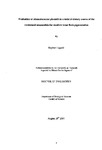Evaluation of Haematococcus pluvialis as a natural dietary source of the carotenoid astaxanthin for rainbow trout flesh pigmentation
| dc.contributor.author | Lagocki, Stephen | |
| dc.contributor.other | Faculty of Science and Engineering | en_US |
| dc.date.accessioned | 2013-11-19T08:39:32Z | |
| dc.date.available | 2013-11-19T08:39:32Z | |
| dc.date.issued | 2001 | |
| dc.identifier | NOT AVAILABLE | en_US |
| dc.identifier.uri | http://hdl.handle.net/10026.1/2747 | |
| dc.description.abstract |
The efficacy of the lipid soluble carotenoid astaxanthin (biosynthesised as a secondary metabolite by the microalga Haematococcus pluvialis) as a source of pigment to enhance the aesthetic appeal of the flesh of farmed salmonid species has been investigated, using rainbow trout (Oncorhynchus mykiss) as a model. Accretion of astaxanthin within rainbow trout epaxial white muscle was primarily shown to be dependent on dietary inclusion and the type of diet used as a pigment carrier. Different dietary inclusion rates demonstrated a dose response. Cold pressed low oil and commercially extruded high oil diets containing similar astaxanthin concentration were tested, fish receiving the latter obtained higher growth rates and retained higher concentrations of astaxanthin within their flesh as compared to those receiving the former. Assessment of intact encysted H. pluvialis cells and processed H. pluvialis cells which had been mechanically treated to ruptured their cell wall revealed that the astaxanthin retained within the cells is only bioavailable to rainbow trout when the cell wall has been breached. The carotenoid profile of H. pluvialis confirmed that its astaxanthin was in three forms, i.e. free (5.9%), mono-esterified (82.3%) and di-esterified (11.8 %) to fatty acid moieties. Assessment of H. pluvialis purified mono and di-esterified astaxanthin extracts fed to rainbow trout demonstrated that astaxanthin mono-esters were more bioavailable than di-esters. Image analysis confirmed the major colour component of pigmented rainbow trout fillets is red and the distribution of astaxanthin within fillets varies greatly, with the head region having the lightest hue, which gradually increases towards the tail region. The addition of 2-palmitoylaminoproprionic acid (Corbinol) as a feed additive to diets containing synthetic astaxanthin had no effect on increasing the deposition of astaxanthin in the epaxial white muscle. Nevertheless, none of the in vivo trials incorporating H. pluvialis cells or H. pluvialis derived astaxanthin extracts demonstrated any detrimental effects on rainbow trout, in terms of feed utilisation, growth performance or health. Also, the protection afforded to astaxanthin by ruptured H. pluvialis cysts was demonstrated (during in vitro experiments) to provide increased stability as compared to synthetic astaxanthin, with respect to diet storage, exposure to emulated sunlight and loss in a turbulent water column. The present studies contribute to the awareness of Haematococcus pluvialis as a source of natural astaxanthin for salmonid species, by highlighting both negative and positive aspects with respect to its use in the aquaculture industry. | en_US |
| dc.language.iso | en | en_US |
| dc.publisher | University of Plymouth | en_US |
| dc.title | Evaluation of Haematococcus pluvialis as a natural dietary source of the carotenoid astaxanthin for rainbow trout flesh pigmentation | en_US |
| dc.type | Thesis | |
| plymouth.version | Full version | en_US |
| dc.identifier.doi | http://dx.doi.org/10.24382/1561 |
Files in this item
This item appears in the following Collection(s)
-
01 Research Theses Main Collection
Research Theses Main


